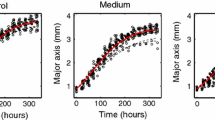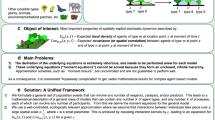Abstract
The class of deterministic ‘Daphnia’ models treated by Diekmann et al. (J Math Biol 61:277–318, 2010) has a long history going back to Nisbet and Gurney (Theor Pop Biol 23:114–135, 1983) and Diekmann et al. (Nieuw Archief voor Wiskunde 4:82–109, 1984). In this note, we formulate the individual based models (IBM) supposedly underlying those deterministic models. The models treat the interaction between a general size-structured consumer population (‘Daphnia’) and an unstructured resource (‘algae’). The discrete, size and age-structured Daphnia population changes through births and deaths of its individuals and through their aging and growth. The birth and death rates depend on the sizes of the individuals and on the concentration of the algae. The latter is supposed to be a continuous variable with a deterministic dynamics that depends on the Daphnia population. In this model setting we prove that when the Daphnia population is large, the stochastic differential equation describing the IBM can be approximated by the delay equation featured in (Diekmann et al., loc. cit.).

Similar content being viewed by others
References
Champagnat N, Ferriére R, Méléard S (2006) Unifying evolutionary dynamics: from individual stochastic processes to macroscopic models. Theor Pop Biol 69:297–321
Champagnat N, Ferriére R, Méléard S (2008) Individual-based probabilistic models of adaptive evolution and various scaling approximations. In: Dalang, R.C., Dozzi, M., Russo, F (eds) Seminar on Stochastic Analysis, Random Fields and Applications V, Centro Stefano Franscini, Ascona, May 2005. Progress in Probability vol. 59, Birkhauser, pp 75–114
Diekmann O, Gyllenberg M (2012) Equations with infinite delay: blending the abstract and the concrete. J Diff Equ 252(2):819–851
Diekmann O, Metz JAJ (2010) How to lift a model for individual behaviour to the population level? Phil Trans Roy Soc London B 365:3523–3530
Diekmann O, Metz JAJ, Kooijman SALM, Heymans HJAM (1984) Continuum population dynamics with an application to Daphnia magna. Nieuw Archief voor Wiskunde 4:82–109
Diekmann O, Gyllenberg M, Metz JAJ, Thieme HR (1998) On the formulation and analysis of general deterministic structured population models I Linear theory. J Math Biol 36:349–388
Diekmann O, Gyllenberg M, Huang H, Kirkilionis M, Metz JAJ, Thieme HR (2001) On the formulation and analysis of general deterministic structured population models. II. Nonlinear Theory. J Math Biol 43:157–189
Diekmann O, Gyllenberg M, Metz JAJ (2003) Steady state analysis of structured population models. Theor Pop Biol 63:309–338
Diekmann O, Getto P, Gyllenberg M (2007) Stability and bifurcation analysis of Volterra functional equations in the light of suns and stars. SIAM J Math Anal 39(4):1023–1069
Diekmann O, Gyllenberg M, Metz J, Nakaoka S, de Roos A (2010) Daphnia revisited: local stability and bifurcation theory for physiologically structured population models explained by way of an example. J Math Biol 61:277–318
Durinx M, Metz JAJ, Meszéna G (2008) Adaptive dynamics for physiologically structured models. J Math Biol 56:673–742
Evans L (1998) Partial Differential Equations, Graduate Studies in Mathematics, vol. 19, American Mathematical Society
Ferriére R, Tran VC (2009) Stochastic and deterministic models for age-structured populations with genetically variable traits. ESAIM: Proceedings 27. pp. 289–310, Proceedings of the CANUM 2008 conference
Fournier N, Méléard S (2004) A microscopic probabilistic description of a locally regulated population and macroscopic approximations. Ann Appl Probab 14(4):1880–1919
Gurney WSC, Nisbet RM (1985) Fluctuation periodicity, generation separation, and the expression of larval competition. Theor Pop Biol 28:150–180
Jacod J, Shiryaev A (1987) Limit Theorems for Stochastic Processes. Springer, Berlin
Jagers P, Klebaner F (2000) Population-size-dependent and age-dependent branching processes. Stoch Proc Appl 87:235–254
Jagers P, Klebaner F (2011) Population-size-dependent, age-structured branching processes linger around their carrying capacity. J Appl Prob 48A: 249–260, special volume: New Frontiers in Applied Probability
Joffe A, Métivier M (1986) Weak convergence of sequences of semimartingales with applications to multitype branching processes. Adv Appl Prob 18:20–65
Kurtz TG (1970) Solutions of ordinary differential equations as limits of pure jump Markov processes. J Appl Prob 7:49–58
Kurtz TG (1981) Approximation of population Processes. SIAM, Philadelphia, PA
Méléard S, Metz JAJ, Tran VC (2011) Limiting Feller diffusions for logistic populations with age-structure, 58th World Statistics Congress of the International Statistical Institute (ISI 2011), Dublin Ireland (July 2011). hal-00595928
Méléard S, Roelly S (1993) Sur les convergences étroite ou vague de processus à valeurs mesures. CRAcadSciParis, Serie I 317:785–788
Méléard S, Tran VC (2009) Trait substitution sequence process and canonical equation for age-structured populations. J Math Biol 58(6):881–921
Méléard S, Tran VC (2012) Slow and fast scales for superprocess limits of age-structured populations. Stoch Proc Appl 122:250–276
Metz JAJ, Diekmann O (1986) The dynamics of physiologically structured populations. Lecture Notes in Biomathematics, vol. 68. Springer, Berlin
Metz JAJ, de Roos AM (1992) The role of physiologically structured population models within a general individual-based modeling perspective. In: DeAngelis DL, Gross LJ (eds) Individual-based models and approaches in ecology. Routledge, Chapman& Hall, London, pp 88–111
Nisbet RM, Gurney WSC (1983) The systematic formulation of populationmodels with dynamically varying instar duration. Theor Pop Biol 23:114–135
Oelschläger K (1990) Limit theorem for age-structured populations. Ann Prob 18(1):290–318
de Roos A, Metz JAJ, Evers E, Leipoldt A (1990) A size dependent predator-prey interaction: who pursues whom? J Math Biol 28(6):609–643
Tran VC (2006) Modéles particulaires stochastiques pour des problémes d’évolution adaptative et pour l’approximation de solutions statistiques. PhD thesis, Université Paris X—Nanterre. http://tel.archives-ouvertes.fr/tel-00125100
Tran VC (2008) Large population limit and time behaviour of a stochastic particle model describing an age-structured population. ESAIM: P&S 12:345–386
Acknowledgments
This work benefitted from the support from the “Chaire Modélisation Mathématique et Biodiversité of Veolia Environnement—Ecole Polytechnique—Museum National d’Histoire Naturelle—Fondation X”.
Author information
Authors and Affiliations
Corresponding author
Additional information
Dedicated to Odo Diekmann on the occasion of his 65th birthday.
Appendices
Appendix A. Proof of Proposition 2
Let \(f(t,\xi ,a)\) be a function of class \(\mathcal C ^1\). From (7), we obtain
Using (2), we have for any \(s<t\):
Recall that we denoted by \(T_k\), \(k\ge 1\) the birth and death events in the population. By convention, we let \(T_0=0\). Let us consider an individual \(i\). Let \(t_0\in \{T_k, k\ge 0\}\) be the birth time of the individual (or 0 if the individual is alive at time \(0\)) and \(a^i_{t_0}\) be its age at time \(t_0\) (0 if \(t_0\) is the birth time). The sum of the terms in the r.h.s. of (23) associated with individual \(i\) is equal to:
The last integral correspond to the death term when individual \(i\) is dead before \(t\). Thus, (23) gives:
where the first bracket corresponds to individuals alive at time \(0\) and where the second bracket correspond to individuals born after time \(0\). For \(s<u\)
provided there has been no jumps between \(s\) and \(u\). Thus, we have:
where \(\widetilde{Q}(ds,di,d\theta )=Q(ds,di,d\theta )-ds\otimes n(di)\otimes d\theta \) is the compensated Poisson point measure associated with \(Q\). The integral with respect to \(\widetilde{Q}(ds,di,d\theta )\) provides the martingale \(M^f\). This achieves the proof. \(\square \)
Appendix B. Sketch of the Proof of Proposition 3
When starting from (11) and using controls of moments as in Fournier and Méléard (2004), the proof is similar to the one in Tran (2008); Tran (2006).
Step 1 We start by noticing that under the Assumption (15), we have the following estimate (e.g. Champagnat et al. 2008):
Moreover, from Assumptions 1 and (5), the size of any individual is bounded on \([0,T]\) by \(\bar{\xi }=\xi _0+\bar{g}T\) and there exists for every \(\varepsilon \) a non random constant \(\bar{S}_\varepsilon \) such that:
From these estimates and Assumption 1 (ii), there exists a constant \(A_\varepsilon \in (0,A)\) such that:
Step 2 It is easy to see that the limiting values of \((Z^n,S^n)_{n\in \mathbb N ^*}\) are necessary continuous. Let us check the \(C\)-tightness (e.g. Jacod and Shiryaev 1987) of \((Z^n,S^n)_{n\in \mathbb N ^*}\) in \(\mathbb D ([0,T],\mathcal{M }_F(\mathbb R _+^2)\times \mathbb R _+)\). Using a criterion by Méléard and Roelly (1993) and given the compact containment that follows from Step 1, it is sufficient to prove the tightness of \((S^n)_{n\in \mathbb N ^*}\) and of the predictable finite variation part and martingale part of \((\langle Z^n,f\rangle )_{n\in \mathbb N ^*}\) for \(f\) in \(\mathcal C _b^1(\mathbb R _+^3,\mathbb R )\) (which contains the constant function equal to 1). This is obtained by using Aldous-Rebolledo criteria (e.g. Joffe and Métivier 1986)) and adapting the arguments of, for instance, Champagnat et al. (2008) and Tran (2008) using the estimates of Step 1.
Step 3 The identification of the martingale problem satisfied by the limiting values provides (16)–(17). Uniqueness of the solution of (16)–(17) stems from the Assumptions 1. As a consequence, there is a unique limiting value and we have convergence in distribution of \((Z^n,S^n)_{n\in \mathbb N ^*}\) to the solution \((\zeta ,\varrho )\). Since the latter is deterministic, the convergence is also a convergence in distribution.
Rights and permissions
About this article
Cite this article
Metz, J.A.J., Tran, V.C. Daphnias: from the individual based model to the large population equation. J. Math. Biol. 66, 915–933 (2013). https://doi.org/10.1007/s00285-012-0619-5
Received:
Revised:
Published:
Issue Date:
DOI: https://doi.org/10.1007/s00285-012-0619-5
Keywords
- Birth and death process
- Age and size-structured populations
- Stochastic interacting particle systems
- Piecewise deterministic motion
- Large population limits




